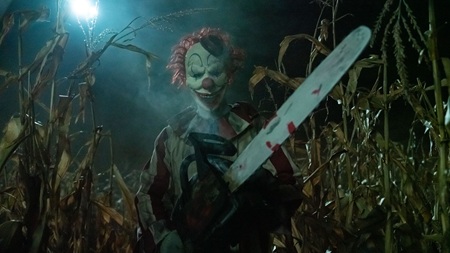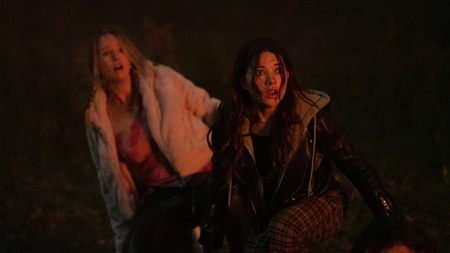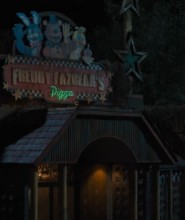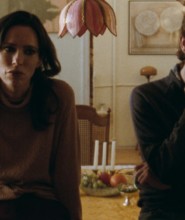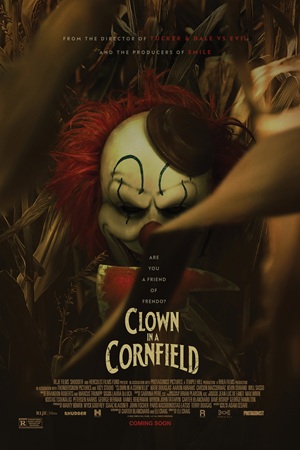
Inventive Clown in a Cornfield is a Gorily Silly Farmland Fright
If nothing else, Clown in a Cornfield delivers on everything hinted at in its title. There is a clown, Frendo, the incarnation of a beloved small-town corporate mascot. This clown spends tons of time in cornfields, and not only because the business he’s the face of happens to make corn syrup but also because that’s where many of the community’s most troublesome teenagers tend to frolic.
Frendo doesn’t take kindly to these pesky kids doing what they shouldn’t in his domain. It makes him downright angry, even homicidal. And if a few teens go missing, never to be seen again? That’s a mystery no one in town seems keen to solve. The world may see Frendo as a happy-go-lucky goofball, but the reality is much darker than that, much deadlier, and this clown wouldn’t have it any other way.
Adapted from the first of a trilogy of young adult novels by author Adam Cesare, the latest horror-comedy hybrid from director Eli Craig may not reach the same stratospheric heights as his 2010 cult favorite Tucker & Dale vs. Evil, but that doesn’t make it any less entertaining. This is a blood-splattered lark that giddily toys with genre conventions, features a wonderful new clown villain in Frendo, and showcases a winning performance by youngster Katie Douglas that immediately cements the actor as someone to keep an eye on.
It also is built on a firm foundation of prescient social and political commentary that’s surprisingly intelligent. The screenplay, written by Craig and Carter Blanchard, has something to say about generational values, economic inequality, gender roles, sexuality, and changing cultural norms. Much like the 1958 version of The Blob or 2011’s Attack the Block, the filmmakers utilize silly — and familiar — genre dynamics to show that the youth have reason to be in revolt, and adults who are unwilling (or unable) to listen, learn, and change with the times do so at their own peril. This film has something worthwhile to say.
My issue is that it doesn’t always say it loudly or continuously enough. There are also several instances where it loses focus. The balance between humor and suspense is noticeably inconsistent. As for the ending, while it does follow the source material rather closely, it’s still strangely abrupt in its adapted form. There’s even a point where a primary character flat-out disappears. This both bewildered and annoyed me.
The good news is that that didn’t keep me from having fun. Craig keeps things fast and loose, and the 96-minute running time ensures that the story never overstays its welcome. While Frendo is no Pennywise (who is?), he’s still a captivating mixture of a Killer Klown from Outer Space and a lesser Ghostface variant (think Scream 3 or the 2022 legacy sequel/soft reboot). Heck, I even think he’s more interesting than Art the Clown from the hyperviolent Terrifier series.
As for the plot, it’s honestly not all that crazy or complex. Dr. Glenn Maybrook (Aaron Abrams) and his high school senior daughter Quinn (Douglas) move to the close-knit community of Kettle Springs for a fresh start. Courtesy of a cantankerous teacher with a vindictive short fuse who stuffs her into detention minutes into her first class, the teenager quickly falls in with what the town sheriff (Will Sasso) unironically refers to as “the wrong crowd.”
This gaggle includes Cole (Carson MacCormac), the confidently handsome son of the powerful owner of the Baypen Corn Syrup company Arthur Hill (Kevin Durand). Cole and his friends make viral “snuff” videos featuring the normally wholesome Frendo as a bloodthirsty serial killer, and there are those in Kettle Springs who take umbrage to this depiction.
What follows is an extreme night of terror, as someone (or some thing) has suited themselves up as Frendo to make a dismembered example out of Cole and anyone else who is friendly with him, and Quinn gets caught in the crossfire. Plenty of inventive kills soon follow, as do heart-stopping revelations involving the Baypen company and the Kettle Springs community going back at least a half-decade.
Douglas is excellent. Her Quinn is determined to not only survive but also show the adults trying to minimize the seriousness of this situation how wrong they are. Additionally, she isn’t going to let them smother her opinions or force her to live in a 1950s Stepford-ized bubble of patriarchal conformity. Quinn will not be defined by outdated gender roles, and she certainly will not endure racial intolerance or homophobia. Douglas makes sure this is one teen who won’t go down without a massive fight.
There are several terrific kills, including one with a chainsaw that almost rivals Craig’s inspired woodchipper mutilation in Tucker & Dale vs. Evil. Most of the laughs are genuine, and, even amid all of the gruesome excess, the emotions fueling the drama are grounded. When Quinn, Cole, and the remainder of their friends encounter a pack of Frendo clones in a farmhouse, the run-in is enthusiastically energetic, while a later scene inside Dr. Maybrook’s cramped office has an anxiously nimble urgency I thoroughly enjoyed.
I don’t know what the staying power of Clown in the Cornfield will be. Craig and Blanchard work hard to bring all of the themes present in Cesare’s source material into their adaptation, but they are only somewhat successful. Yet Frendo is a delightful baddie, and Quinn is an even better heroine. This makes Craig’s comedic foray into farmland fright worthwhile, and if a second hayride with this maniacal clown ever materializes, I’m going to make sure and be one of the first to grab a seat.
– Review reprinted courtesy of the SGN in Seattle
Film Rating: 3 (out of 4)


